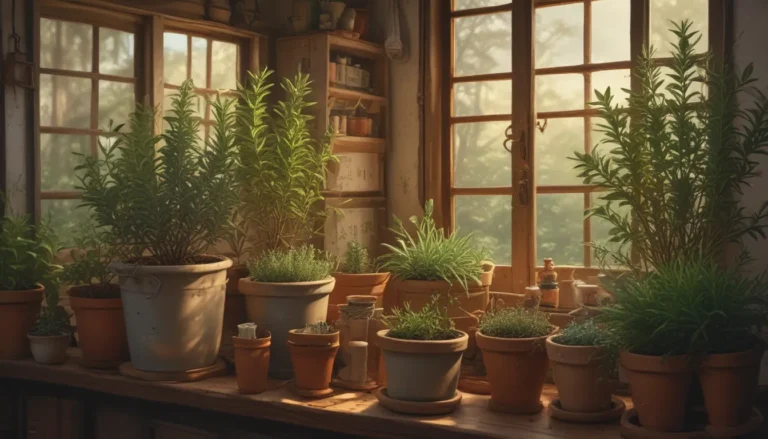How to Successfully Plant and Grow Ginger in Your Home Garden

We’ve all encountered ginger – the aromatic spice that adds a special touch to various dishes and beverages. While it’s readily available in grocery stores worldwide, have you ever considered growing it at home?
Growing ginger presents a unique challenge as it is a tropical plant, sensitive to colder temperatures. But fear not, with the right techniques and sufficient care, you can cultivate this culinary favorite even in non-tropical regions. In this comprehensive guide, we will delve into the intricacies of planting and caring for ginger in your home garden, offering valuable tips and insights to help you succeed.
What You’ll Discover in This Guide
- Origins of Ginger
- Planting Timing
- Overcoming Challenges in Colder Climates
- Essential Tips for Successful Growth
- How to Harvest and Propagate Ginger
Join us as we uncover the secrets to cultivating this versatile spice right at home.
The Origin and Source of Ginger
Most commercially available ginger originates in tropical regions such as southern China, India, Indonesia, or West Africa. Thriving in hot and humid conditions, ginger is a staple ingredient in these areas, easily grown in both large-scale farms and home gardens.
While ginger flourishes in tropical and sub-tropical climates, it poses a challenge for cultivation in regions with colder temperatures. In the US, areas such as Southern Texas, Florida, Southern California, Southern Arizona, and Hawaii provide suitable conditions for year-round growth of ginger.
Planting Time: A Crucial Step
To embark on your ginger-growing journey, begin by procuring ginger rhizomes from your local grocery store or farmers market. Opt for roots that are healthy, large, and at least four to six inches long, with multiple ‘fingers’ extending from them.
Planting should ideally take place in full to partial shade, with rich, well-draining soil. Whether you choose to plant directly in the ground or in pots, ensure the soil is of high quality to support healthy growth.
Follow these steps to plant ginger successfully:
- Amend soil with compost or aged manure if necessary.
- Opt for early spring planting, with flexibility in warmer climates.
- Cut rhizomes into one to two-inch pieces, each with at least one bud.
- Allow the cut sections to dry for 24 to 48 hours before planting.
- Space out the rhizome pieces at least 12 inches apart, planting them no deeper than one inch.
- Water thoroughly post-planting.
- Expect leaves to emerge within a week.
- Water sparingly yet deeply after initial growth.
By following these steps, you can set the stage for healthy ginger growth in your home garden.
Adapting to Colder Climates
If you reside in a colder climate, growing ginger year-round may present a challenge due to its tropical nature. According to the USDA Hardiness Zones map, ginger thrives best in Zones 9 or higher, thereby limiting its cultivation in regions with lower hardiness zones.
To ensure successful growth in colder climates, maintain temperatures above 55°F at all times, ideally between 55 and 60°F. Frost and freezing temperatures can induce dormancy or even damage the plant irreversibly, emphasizing the need for continuous warmth.
5 Tips for Growing Ginger in Colder Regions
Here are essential tips to help you grow ginger successfully in colder climates:
- Pot It: Cultivate ginger in pots for mobility and indoor protection during colder seasons.
- Transplant Seasonally: Consider transplanting ginger in and out of your garden to safeguard against temperature fluctuations.
- Soil Considerations: Opt for fertile, well-draining soil akin to ginger’s native habitat.
- Careful Watering: Maintain consistent moisture without waterlogging to prevent rot.
- Harvest Strategically: Harvest ginger at the desired time without harming the plant’s long-term viability.
By implementing these strategies, you can overcome the challenges of cooler climates and enjoy bountiful ginger harvests year-round.
Ginger Quick Reference Growing Chart
- Plant Type: Root Crop, Perennial
- Tolerance: Shade
- Native to: Tropical Africa, Asia
- Maintenance: Moderate
- Hardiness (USDA Zone): 9-12
- Soil Type: Rich, loamy
- Season: Requires year-round temperate conditions for outdoor cultivation
- Soil pH: Slightly acidic (5.5 to 6.5)
- Exposure: Partial to full shade
- Soil Drainage: Well-draining
For a detailed summary of optimal conditions and care practices for ginger growth, refer to the Quick Reference Growing Chart provided above.
Get Growing!
In conclusion, growing ginger in your home garden, regardless of your climate, is an achievable and rewarding endeavor. With careful planning, proper care, and adherence to essential tips, you can enjoy a thriving ginger plant right at home.
Share your experiences with growing ginger in the comments below and stay tuned for more herb gardening guides to enhance your green thumb skills!





